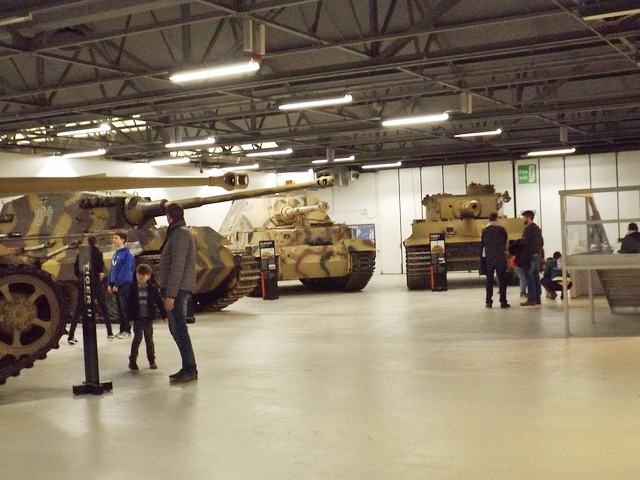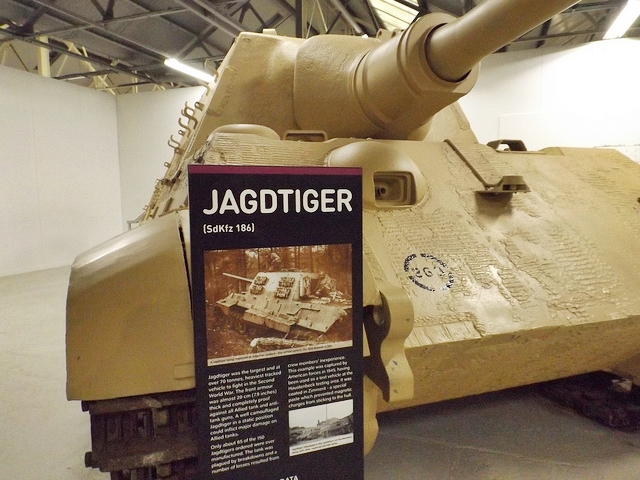
The Second World War resulted in the deaths of around 85 million people. Additionally, tens of millions more people were displaced. However, amid all the carnage people demonstrated remarkable courage, fortitude, compassion, mercy and sacrifice. We would like to honour and celebrate all of those people. In the War Years Blog, we examine the extraordinary experiences of individual service personnel. We also review military history books, events, and museums. And we look at the history of unique World War Two artefacts, medals, and anything else of interest.
Face to Face with the German Tiger tank
In this article, we look at the merits and deficiencies of the German Tiger tank during World War Two, and the muddled strategic thinking that drove the project forward.
The Tiger tank (Panzerkampfwagen VI Tiger Ausf. E) entered service at the end of 1942. It was not a great start. The tank was deployed over unsuitable terrain, limiting its effectiveness. The early production Tigers were plagued with technical problems including dangerous engine fires. Many of these early teething problems were symptoms of the tank being rushed into service without adequate development and testing. However, the Tiger was also over-engineered. The result was a highly complex, often temperamental weapons system that required extensive preventative maintenance and careful handling.
Fighting the Wrong War
Manufactured by Henschel, the Tiger I Ausf. E was the product of creaky strategic thinking. The Tiger was not built in response to Soviet tanks like the T-34 and KV-1. Instead, the Tiger was designed as a “sledgehammer” to smash holes in the enemy’s lines, which support units could then exploit. However, the Germans were already fighting a largely defensive war by late 1942. The days of the blitzkrieg were over. A far better solution would have been to concentrate all manufacturing resources on producing the reliable, very effective Panzer IV main battle tank (MBT).
60 Tonne Sledgehammer
Although the Tiger had many deficiencies, it was not without merit. In the hands of a well-trained and experienced crew who understood the Tiger’s advantages, the tank could prove a formidable opponent. Tank design is about achieving the right balance of mobility, armour and firepower so the vehicle can perform its primary task. Clearly, the Tiger was designed as a sledgehammer, and that’s what the panzer forces got. The Tiger weighed in at just under 60 tonnes, with 100mm frontal armour, 80mm side and rear armour, two MG-34 machine guns, and a high velocity, flat trajectory 88mm main gun.
40 Percent Reliable
The Tiger’s 88mm main gun fired both armour piercing (AP) and high explosive (HE) shells. Officially, the tank could store 92 rounds. However, crews typically packed as many additional shells into every available space as possible. Although the tank was underpowered by the Maybach HL230 700-horsepower petrol engine, it was surprisingly quick and agile on good ground. A semi-automatic gearbox and steering wheel also made the tank easy to drive. Nevertheless, even when the tank was well maintained and supported by a good workshop company, the Tiger’s overall reliability was abysmal. Most Tiger Is were only operational 40 per cent of the time. The reliability of other Tiger variants such as Tiger II Ausf. B, Panzerjager and Jagdtiger were even worse.
Recovery No Easy Task
Naturally, broken down and battle-damaged tanks need to be recovered, whenever possible. Unfortunately, the Tiger’s size and weight often worked against easy recovery. Typically, it took two or three prime movers (tractors) to tow a Tiger to safety. Panzer units were under strict orders not to use one Tiger to tow another, as this could result in damaging the second tank. However, necessity often trumped orders and Tigers frequently towed one another. Later, specialist recovery tanks were introduced, such as the Bergepanther, but these vehicles were always in short supply.
The Importance of Training
How well or poorly an individual tank performs is mainly reliant on the quality and training of the crew. As the war progressed and losses mounted, the German army struggled to provide adequate manpower or training to its panzer forces. Subsequently, overall performance suffered. However, the Germans valued the lives of their panzer crews, and the Tiger provided a separate escape hatch for each man. Many Allied tanks were not designed as well, resulting in men being trapped inside burning vehicles after they had been hit. When it came to training Tiger crews, the official manual was surprisingly innovative. The Tigerfibel aimed to convey complex battlefield instructions in a simple and memorable manner to young recruits using cartoons, jokes and risqué pictures of women. Even today, you can buy a copy in English translation on Amazon.
The Unsinkable Tiger
Thanks to a combination of thick, seemingly impervious frontal armour, the legendary 88mm gun and copious amounts of Nazi propaganda, the Tiger quickly gained a reputation for impregnability. Of course, the Tiger was as impregnable as the Titanic was unsinkable. In reality, the Tiger’s main value came from its ability to stand off and deal with its opponents at a distance. However, even with mid and late-production improvements, by 1944 the Tiger was fighting a losing battle.
The Victory of Mass Production
The Germans went for quality over quantity in tank production, but a lack of time and resources meant they never really delivered on quality. They also chose to pursue an obsolete military strategy at odds with the realities of their situation. In contrast, the Allies went for simple, reliable vehicles they could mass-produce in vast quantities. Over 110,000 Soviet T-34 and American M4 Sherman medium tanks were manufactured compared with just over 1,300 Tiger I Ausf. E. That’s 85 to one, and only half the Tigers would be fit for service at any time. What’s more, the Allies didn’t stand still. They improved their existing tank forces and introduced new, heavier tanks. The British Comet, for example, entered service in December 1944. Ultimately, the Tiger only ever won the propaganda war. In all other respects, the Tiger was a costly, unreliable failure.
Tiger Tank artefact: Falaise Pocket August 1944
In this blog post, we take a look at a battlefield-recovered piece of Tiger tank history from the Falaise Pocket, in August 1944.
366 miles and 73 years is quite a journey for an inanimate lump of metal and glass, but then this item was once a vision block sitting in the command’s cupola of a German mid-production Panzerkampfwagen Tiger Ausf. E. The German Tiger tank established a fearsome battlefield reputation on both the Eastern and Western fronts during World War Two. Today, only seven Tiger Is remain in various states of repair and preservation of the 1,347 manufactured. The star of the Hollywood movie, Fury, the Tank Museum’s Tiger 131 is the only example still running. Therefore, I was very excited to find a genuine Tiger tank artefact at the 2017 Overlord Show. However, I believe the same vision blocks were also used in the much more numerous German Panzer IV.
Tiger 1E model illustrates the commander's cupola and vision blocks
Vision block, mid-production Tiger tank destroyed, Falaise Pocket, Normandy 1944
I have mixed feelings about the trade in battlefield-recovered historic items, and think it must be strictly controlled. However, the opportunity to own just a small piece of the Tiger legend got the better of me. The extremely corroded condition of my vision block suggests if it had remained buried, it would have eventually disintegrated. Instead, I will do my best to preserve it and the history. So, how did my Tiger meet its end?
The final act of a savage campaign that started on the D-Day beaches of Normandy, the Battle of the Falaise Pocket was played out from the 12 to 21 August 1944. Having fought a tremendous but costly defensive battle across the Norman countryside, German Army Group B, the 7th Army and Fifth Panzer Army found themselves squeezed into a shrinking pocket around Falaise. Although the Germans were able to keep a corridor open for retreating forces, most of Army Group B on the western side of the river Seine was destroyed, opening the road to Paris.
The Vimoutiers Tiger, Normandy
Better suited to the open steppe of Russia than the claustrophobic sunken lanes and hedgerows of Normandy, the Tiger tank adapted well to defensive fighting. On 13 June 13 1944, the British 7th Armoured Division’s attack towards Villers-Bocage was blunted by a handful of SS Tigers tanks. Repeatedly, the Germans skilfully deployed their limited resources of equipment and men with devastating effects. Nevertheless, Allied numbers, air superiority, the weight of firepower and logistical support eventually won the day. Gradually, British and Canadian operations such as Epsom, Charnwood, Goodwood and Bluecoat denuded German forces of their best, irreplaceable units. This freed the American Third Army under General George Patton to strike toward Brittany.
Rather than be allowed to organise a strategic withdrawal, Field Marshal Günther von Kluge, commander of Army Group B, was forced to launch a costly counterattack attack at Mortain. In reality, this weak German offensive actually placed them in greater peril than the American forces it was supposed to stop. On 8 August, General Bernard Montgomery ordered Allied forces to converge on the Falaise–Chambois region. As the trap closed, the Germans started to withdraw, often having to fight their way through Allied lines, abandoning vehicles and heavy weapons. By 21 August, around 50,000 German troops found themselves inside the Falaise Pocket. Just two days later, the Allies were in Paris.
Charlie and Tiger 131, the World's only operational Tiger I
The Battle of Normandy was exceptionally costly. British, Canadian and Polish ground forces suffered 83,045 casualties. The Americans lost 125,847. German casualties are harder to establish, but roughly 200,000 killed and wounded. Sadly, although far better than British tanks, the American mainstay was the M4 Sherman. This was no match for the Tiger. The US 3rd Armoured Division, for example, suffered a loss rate of 580 percent during its time fighting in Europe.
According to Stephen Napier’s book, The Armoured Campaign in Normandy, June – August 1944, the Germans lost 1,223 tanks and self-propelled guns in the Falaise Pocket, half the armour they committed to the Normandy campaign. 75% of those vehicles found in the pocket were either destroyed by their crews or simply abandoned. In comparison, the Allies lost 2,700 tanks destroyed in Normandy. This would suggest the Allies lost two to three tanks for every German panzer. At the same time, certain German units seem to have exaggerated their claims of Allied tank kills. Although relatively few in numbers, the Tiger tanks that fought in Normandy had a terrific psychological effect on the Allies. It is also true that occasionally, lone or small groups of Tigers savaged their opponents, but overall numbers were decisive in the Allied victory.
If you've enjoyed this blog post then please share and join The War Years on Facebook







